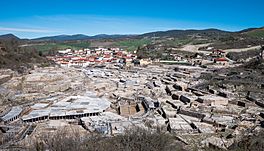Salt Valley of Añana facts for kids
Quick facts for kids Salt Valley of Añana |
|
|---|---|

View of the valley, with Salinas de Añana in the background
|
|
| Location | Añana, Álava, Basque Country, Spain |
| Coordinates | Lua error in Module:Coordinates at line 614: attempt to index field 'wikibase' (a nil value). |
| Type | Salt evaporation pond |
| Native name | |
| Surface area | 13 ha (32 acres) |
| Designated: | 24 October 2002 |
| Part of: | Lago de Caicedo-Yuso y Salinas de Añana |
| Reference #: | 1258 |
| Designated: | 17 July 1984 |
| Reference #: | RI-51-0005132 |
The Salt Valley of Añana is a special place in the Basque Country, Spain. It's an inland area where salt is made by letting salty water dry up. This process uses many small pools, called salt evaporation ponds.
The salty water comes from four natural springs at the top of the valley. This water is then moved into the ponds. The sun and wind help the water evaporate, leaving the salt behind. People have been getting salt from this valley for a very long time.
Contents
History of Salt Production
People first started getting salt from the Añana valley about 7,000 years ago. This was during the Neolithic period, a time when early humans began farming. Back then, they would heat salty water in clay pots to make the water evaporate faster.
Roman Times and Early Growth
When the Romans arrived, they introduced a new method. They built special salt ponds where the water could dry up naturally. This made salt production much easier.
The town of Salinas de Añana grew up next to the valley. It became an official town in 1140. This shows how important salt production was to the area.
Royal Control and Changes
In 1564, King Philip II created a "salt monopoly." This meant that only the government could control how salt was made and sold. Salt production in the valley had to follow strict rules set by the authorities.
In 1801, the system for moving water around the valley was completely updated. This made the salt production much more efficient. However, the monopoly ended in 1869. Control of the salt works then went back to the local people.
Modern Challenges and Restoration
In the early 1900s, new building materials like concrete were used to improve the salt ponds. The number of ponds also increased.
However, in the second half of the 20th century, it became much cheaper to produce salt from the sea. This made salt production in Añana less profitable. As a result, people started to abandon the salt works, and the structures began to fall apart.
To protect this important historical site, the Spanish government declared it a Bien de Interés Cultural in 1984. This means it's a site of cultural interest. Around this time, a project began to restore the valley. This restoration work is still ongoing today. In 2012, the Salt Valley of Añana was added to the World Heritage tentative list. This means it might one day become a UNESCO World Heritage Site.
See also
 In Spanish: Valle Salado (Añana) para niños
In Spanish: Valle Salado (Añana) para niños

